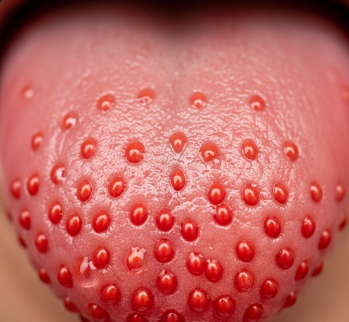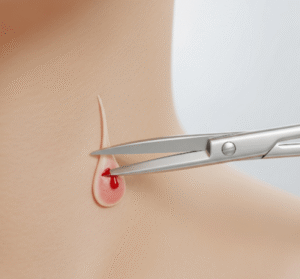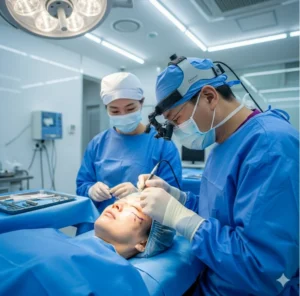➤ Overview
Strawberry tongue is a clinical symptom where the tongue appears red, swollen, and covered with prominent papillae, resembling the surface of a strawberry. This appearance is often associated with systemic infections, inflammatory conditions, or allergic reactions.
In South Korea, strawberry tongue is evaluated by pediatricians, dermatologists, and infectious disease specialists. Recognizing this symptom is crucial for early diagnosis of underlying conditions such as Kawasaki disease, scarlet fever, or toxic shock syndrome, and for initiating timely treatment to prevent complications.
➤ Key Facts
→ Strawberry tongue is a visual sign, not a disease itself.
→ It may appear reddish with enlarged papillae and sometimes a white coating that later sheds.
→ Commonly associated with scarlet fever, Kawasaki disease, or streptococcal infections.
→ In Korea, healthcare providers perform clinical examination, laboratory tests, and supportive therapy.
→ Early recognition is critical to prevent serious complications such as cardiac involvement in Kawasaki disease.
→ The condition can occur in children and adults, although pediatric cases are more common.
→ Management involves treating the underlying infection or inflammatory cause.
➤ What is Strawberry Tongue?
Strawberry tongue is characterized by a red, swollen tongue with enlarged taste buds (papillae):
→ Acute phase – Tongue may have a white coating with red papillae visible.
→ Subacute phase – White coating peels, leaving a bright red tongue with prominent papillae.
→ Inflammatory response – Often caused by systemic toxins or immune-mediated reactions.
→ Indicator of systemic illness – Helps clinicians identify conditions requiring urgent attention.
Korean physicians emphasize clinical observation, correlation with systemic symptoms, and laboratory confirmation to determine the underlying cause.
➤ What Symptoms are Related to Strawberry Tongue?
Strawberry tongue often occurs with additional systemic or local symptoms:
→ Fever – Often high, especially in Kawasaki disease or scarlet fever.
→ Rash – Diffuse red rash on the body, commonly seen in scarlet fever.
→ Redness of oral mucosa – Inflammation of the lips and throat.
→ Swelling of hands and feet – Common in Kawasaki disease.
→ Irritability or malaise – Generalized discomfort in children.
→ Sore throat or difficulty swallowing – If caused by streptococcal infection.
→ Conjunctival redness – Seen in systemic inflammatory conditions.
→ Peeling of skin – Hands and feet may peel after acute illness.
➤ What Causes / Possible Causes?
Strawberry tongue arises from various infectious, inflammatory, or toxic conditions:
→ Scarlet fever – Caused by group A Streptococcus infection; prominent red tongue with white coating.
→ Kawasaki disease – Pediatric vasculitis with strawberry tongue, rash, and fever.
→ Toxic shock syndrome – Systemic bacterial toxin causing tongue inflammation.
→ Vitamin deficiencies – Rarely, B-complex deficiencies can alter tongue appearance.
→ Allergic reactions – Certain drugs or foods may trigger oral mucosal changes.
→ Other systemic infections – Viral infections or sepsis may occasionally present with strawberry tongue.
➤ When Should I See My Doctor?
Immediate medical attention is necessary if strawberry tongue is accompanied by systemic symptoms or persists:
→ High fever lasting more than 24 hours.
→ Rash spreading over the body, especially with desquamation (peeling).
→ Redness or swelling of hands and feet, particularly in children.
→ Sore throat with difficulty swallowing or respiratory symptoms.
→ Signs of toxicity, irritability, or lethargy in children.
→ Suspected Kawasaki disease or scarlet fever requiring urgent intervention.
→ Persistent tongue redness beyond a few days without treatment.
➤ Care and Treatment
Treatment of strawberry tongue focuses on addressing the underlying cause, managing symptoms, and preventing complications:
→ Antibiotic therapy – For bacterial infections such as scarlet fever.
→ Anti-inflammatory medications – To reduce systemic inflammation in Kawasaki disease.
→ Supportive care – Hydration, rest, and symptomatic relief for fever and discomfort.
→ Monitoring for complications – Cardiac evaluation in Kawasaki disease.
→ Oral hygiene – Gentle cleaning to prevent secondary infections.
→ Pain relief – Analgesics for sore throat or oral discomfort.
→ Allergy management – If drug or food allergy is suspected.
→ Follow-up care – To ensure complete recovery and prevent recurrence.
➤ Treatment Options in Korea
South Korea offers comprehensive care for patients with strawberry tongue, combining diagnostic evaluation, medical treatment, and supportive care:
Diagnosis in Korea
→ Clinical examination by pediatricians, dermatologists, or infectious disease specialists.
→ Laboratory tests: throat swabs, blood tests, or cultures to confirm infection.
→ Imaging or cardiac evaluation if Kawasaki disease is suspected.
Medical Treatments in Korea
→ Antibiotics for confirmed streptococcal infections.
→ Intravenous immunoglobulin (IVIG) and aspirin therapy for Kawasaki disease.
→ Symptomatic medications including antipyretics, analgesics, and hydration support.
Advanced Therapies in Korea
→ Close monitoring in hospital settings for severe systemic illness.
→ Integrative approaches combining Western medicine with Korean traditional supportive care.
→ Multidisciplinary follow-up for cardiac, dermatologic, and oral health after acute illness.
Rehabilitation & Support in Korea
→ Education on oral care, symptom monitoring, and preventive measures.
→ Follow-up for children recovering from Kawasaki disease or severe infections.
→ Support for nutrition, hydration, and overall recovery to ensure long-term health.













